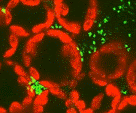Plant Pathology Department
Document Type
Article
Date of this Version
June 2006
Abstract
A series of in-frame and nested deletion mutations which progressively removed 5′-proximal sequences of the Wheat streak mosaic virus (WSMV) HC-Pro coding region (1152 nucleotides) was constructed and evaluated for pathogenicity to wheat. WSMV HC-Pro mutants with 5′- proximal deletions of 12 to 720 nucleotides systemically infected wheat. Boundary sequences flanking the deletions were stable and unaltered by passage through plants for all deletion mutants except HCD12 (lacking HC-Pro codons 3–6) that exhibited strong bias for G to A substitution at nucleotide 1190 in HC-Pro codon 2 (aspartic acid to asparagine). HC-Pro mutants with 5′-proximal deletions of up to 720 nucleotides retained autoproteolytic activity in vitro. In contrast, 5′-proximal deletion of 852 nucleotides of the HC-Pro coding region (HCD852) abolished both infectivity and in vitro proteolytic activity, confirming that the proteolytic domain of WSMV HC-Pro resides within the carboxy-terminal third of the protein and includes the cysteine proteinase motif (GYCY) conserved among four genera of the family Potyviridae. Inoculation of wheat with HC-Pro deletion mutants also bearing the GUS reporter gene revealed that HCD852 was unable to establish primary infection foci in inoculated leaves, indicating that processing of the P3 amino-terminus was essential. Deletion of as few as 24 nucleotides of HC-Pro (codons 3–10) eliminated transmission by the eriophyid mite vector Aceria tosichella Keifer. Collectively, these results demonstrated similar organization of proteinase and vector transmission functional domains among divergent HC-Pro homologues encoded by potyviruses and tritimoviruses. Published by Elsevier Inc.



Comments
Published in Virology 350 (2006) 465–474. www.elsevier.com/locate/yviro